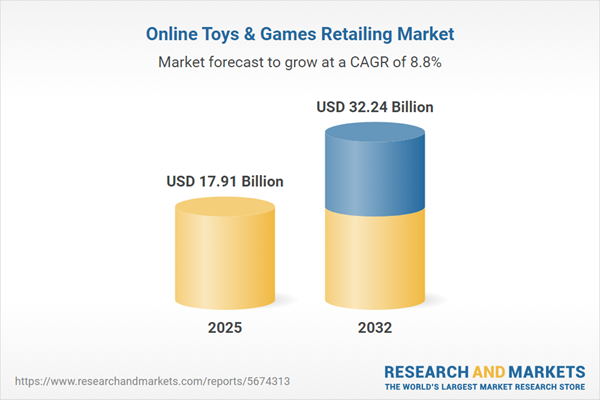Speak directly to the analyst to clarify any post sales queries you may have.
The online toys and games retailing market is navigating a dynamic era marked by digital innovation, emerging consumer demands, and shifting global trade dynamics. Senior decision-makers require actionable insights to maintain competitiveness in an industry where user expectations and operational complexity are constantly evolving.
Market Snapshot of the Online Toys & Games Retailing Market
The Online Toys & Games Retailing Market grew from USD 16.44 billion in 2024 to USD 17.91 billion in 2025. It is expected to continue expanding at a CAGR of 8.78%, reaching USD 32.24 billion by 2032.
Scope & Segmentation of Online Toys and Games Retailing
This comprehensive report offers strategic analysis and forecasts across multiple market dimensions to guide forward-focused stakeholders. The research examines key product categories, consumer age groups, evolving sales channels, platform trends, and regional markets to provide a holistic perspective.
- Product Types: Action Figures; Board & Puzzle Games (covering Family Board Games, Jigsaw Puzzles, and Strategy Board Games); Dolls; Educational Toys (including Language Learning Toys, Montessori Toys, and STEM Toys); Electronic Toys (such as Gaming Tablets, Remote Control Vehicles, Robotic Toys); Outdoor & Sports Toys; Plush Toys.
- Age Groups: 0-2; 3-5; 6-8; 9-12; 13+ (with specific focus on Teens 13-17 and Adults 18+).
- Sales Channels: Brand Websites; Marketplaces; Social Commerce.
- Platforms: Console Gaming (Nintendo, PlayStation, Xbox); Mobile Gaming (Android, iOS); PC Gaming.
- Geographical Regions: Americas (including North and Latin America); Europe, Middle East & Africa (noting major economies in Europe, Middle East, and Africa); Asia-Pacific (key economies across East Asia, Southeast Asia, and Oceania).
- Leading Companies: Amazon.com, Alibaba Group, Walmart, JD.com, Target, eBay, LEGO Group, GameStop, Mattel, Hasbro.
Key Takeaways for Senior Decision Makers
- The online toys and games retailing market is transforming through deeper personalization, with innovations like AI-driven recommendations and augmented reality, which enhance customer experience and drive conversion.
- Demographic segmentation reveals varied product demand patterns: younger consumers prioritize educational and interactive play, while older segments show increasing interest in collectibles and complex board games.
- Sustainability and circular economy initiatives are not only regulatory responses but key competitive differentiators, prompting brands to prioritize eco-friendly designs, packaging, and transparent supply chains.
- Sales channels are diversifying, with direct-to-consumer models, marketplaces, and social commerce offering brands new opportunities to target specific customer segments and optimize their go-to-market strategies.
- Collaboration between toy manufacturers and entertainment franchises is fueling the development of hybrid ecosystems that blend physical and digital play, increasing customer retention and brand relevance.
- Regional adaptation is essential, as consumer preferences and regulatory environments vary widely across Americas, EMEA, and Asia-Pacific, influencing product adoption and omnichannel strategies.
Tariff Impact on Online Toys and Games Supply Chains
Recent United States tariffs applied to toys and games in 2025 introduced supply chain cost pressures. Retailers and manufacturers adapted by exploring alternative sourcing, renegotiating logistics agreements, and localizing fulfillment strategies to mitigate disruption. Temporary absorption of increased costs was managed through operational improvements and tactical pricing. The long-term focus is on diversifying supplier bases and optimizing tariff classifications to sustain margins and ensure supply chain resilience.
Methodology & Data Sources
This report applies a mixed-methods research design. Primary data stems from executive interviews across the retail, logistics, and manufacturing spectrum, supported by expert insights from supply chain specialists and consumer behavior analysts. Secondary research includes industry publications, regulatory filings, and financial disclosures. Data triangulation and independent peer review validate both quantitative and qualitative findings.
Why This Report Matters for Strategic Online Toys and Games Retailing
- Enables senior leaders to anticipate disruptive trends by arming them with granular segmentation data, actionable innovation insights, and region-specific market intelligence.
- Supports informed decision-making with a focus on supply chain robustness, regulatory compliance, and operational adaptability across both legacy and new distribution channels.
- Empowers organizations to align product development, marketing, and partnership strategies for optimal impact in a market that increasingly values personalized experiences and sustainability.
Conclusion
Digital innovation, sustainability imperatives, and regional diversity are shaping the future of online toys and games retailing. Stakeholders who prioritize agility, data-driven strategy, and operational excellence will capture growth and secure relevance in the evolving marketplace.
Additional Product Information:
- Purchase of this report includes 1 year online access with quarterly updates.
- This report can be updated on request. Please contact our Customer Experience team using the Ask a Question widget on our website.
Table of Contents
3. Executive Summary
4. Market Overview
7. Cumulative Impact of Artificial Intelligence 2025
Companies Mentioned
The companies profiled in this Online Toys & Games Retailing market report include:- Amazon.com, Inc.
- Alibaba Group Holding Limited
- Walmart Inc.
- JD.com, Inc.
- Target Corporation
- eBay Inc.
- The LEGO Group
- GameStop Corp.
- Mattel, Inc.
- Hasbro, Inc.
Table Information
| Report Attribute | Details |
|---|---|
| No. of Pages | 192 |
| Published | November 2025 |
| Forecast Period | 2025 - 2032 |
| Estimated Market Value ( USD | $ 17.91 Billion |
| Forecasted Market Value ( USD | $ 32.24 Billion |
| Compound Annual Growth Rate | 8.7% |
| Regions Covered | Global |
| No. of Companies Mentioned | 11 |









